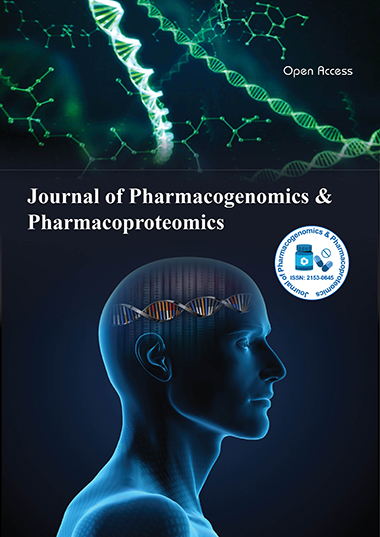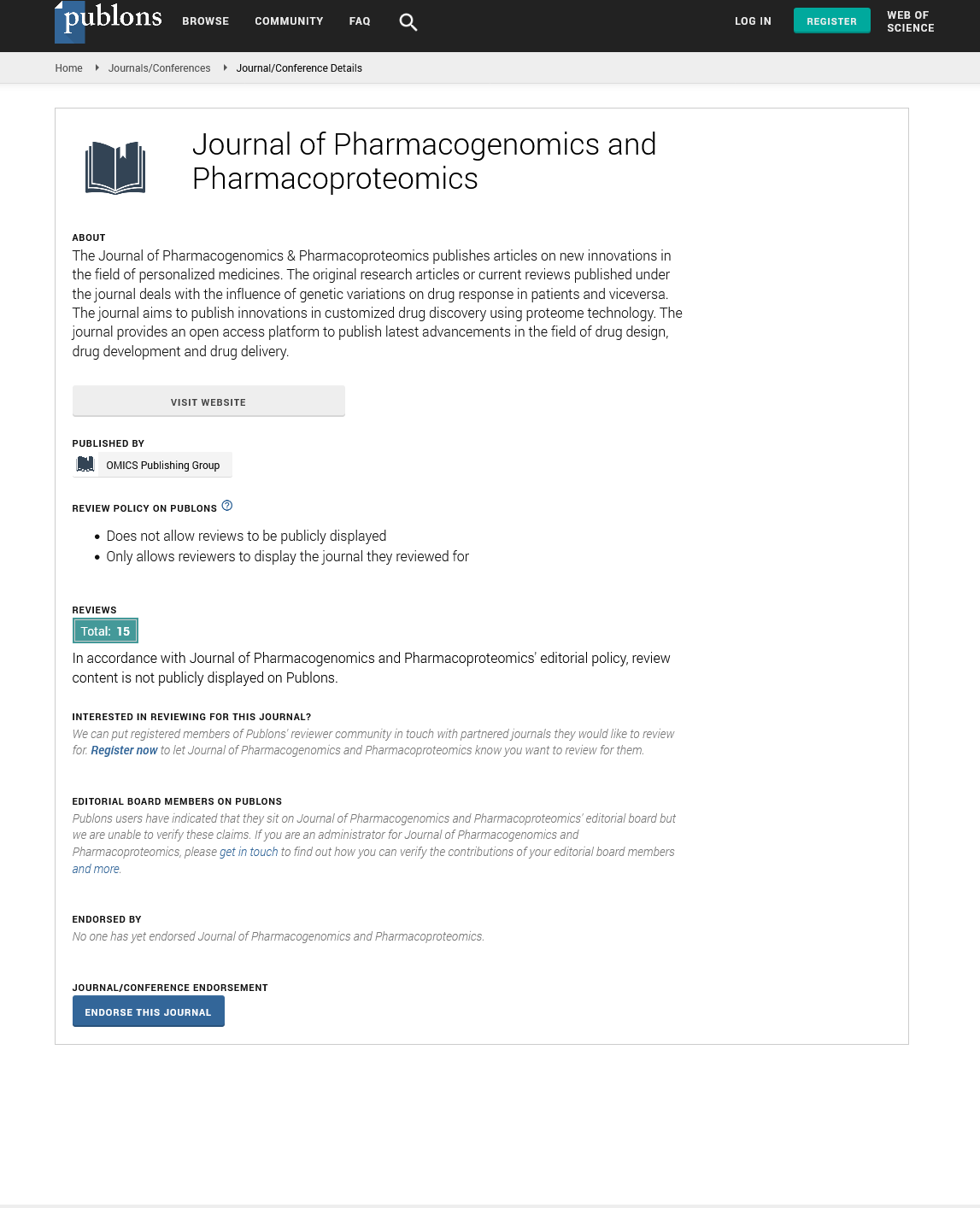Indexed In
- Open J Gate
- Genamics JournalSeek
- Academic Keys
- JournalTOCs
- ResearchBible
- Electronic Journals Library
- RefSeek
- Hamdard University
- EBSCO A-Z
- OCLC- WorldCat
- Proquest Summons
- SWB online catalog
- Virtual Library of Biology (vifabio)
- Publons
- MIAR
- Euro Pub
- Google Scholar
Useful Links
Share This Page
Journal Flyer

Open Access Journals
- Agri and Aquaculture
- Biochemistry
- Bioinformatics & Systems Biology
- Business & Management
- Chemistry
- Clinical Sciences
- Engineering
- Food & Nutrition
- General Science
- Genetics & Molecular Biology
- Immunology & Microbiology
- Medical Sciences
- Neuroscience & Psychology
- Nursing & Health Care
- Pharmaceutical Sciences
Opinion Article - (2025) Volume 16, Issue 1
COMT Val158Met Polymorphism and Its Influence on Dopaminergic Drug Response in Schizophrenia
Emilia Petrova*Received: 26-Feb-2025, Manuscript No. JPP-25-29334; Editor assigned: 28-Feb-2025, Pre QC No. JPP-25-29334(PQ); Reviewed: 14-Mar-2025, QC No. JPP-25-29334; Revised: 21-Mar-2025, Manuscript No. JPP-25-29334(R); Published: 28-Mar-2025, DOI: 10.4172/2153-0645.25.16.132
Description
Schizophrenia is a complex neuropsychiatric disorder characterized by a diverse array of positive, negative and cognitive symptoms. Although antipsychotics targeting dopaminergic pathways remain the cornerstone of treatment, therapeutic outcomes and side effect profiles vary widely among patients. One of the most investigated pharmacogenetics factors influencing this variability is the Catechol-O-Methyltransferase (COMT) gene, particularly the Val158Met polymorphism (rs4680), which plays a essential role in dopamine metabolism in the prefrontal cortex.
The COMT enzyme catalyzes the degradation of catecholamine’s, including dopamine. The Val158Met SNP results in a Valine (Val) to Methionine (Met) substitution at codon 158, leading to a three- to four-fold reduction in enzymatic activity in Met/Met individuals compared to Val/Val carriers. This difference significantly alters dopamine availability in the brain, especially in the prefrontal cortex, a region critical for cognitive control and working memory.
Numerous clinical pharmacogenetics studies have demonstrated that COMT genotype can influence response to dopaminergic drugs, particularly atypical antipsychotics such as clozapine, risperidone and olanzapine. Patients with the Met/Met genotype, who have higher prefrontal dopamine levels, often show enhanced cognitive improvement with antipsychotics but may also be more susceptible to drug-induced side effects such as sedation or weight gain. Conversely, Val/Val individuals may require higher doses for optimal response, particularly in cognitive and negative symptom domains.
A study conducted at the Sofia Institute of Clinical Neurosciences involving 260 patients with schizophrenia revealed that Met/Met carriers exhibited significantly greater improvement in executive function tasks following 12 weeks of risperidone therapy compared to Val/Val individuals. These findings suggest that COMT genotyping could be used to predict and optimize treatment response in specific symptom domains of schizophrenia.
In addition to treatment efficacy, COMT genotype may also impact susceptibility to Extrapyramidal Symptoms (EPS) and metabolic syndrome. Some studies have shown that Val allele carriers, due to lower prefrontal dopamine tone, may experience more pronounced dopaminergic blockade effects, increasing the risk of motor side effects. Meanwhile, the Met allele has been linked to greater metabolic disturbances, potentially due to dopaminergic modulation of hypothalamic control of appetite and energy expenditure.
Despite the growing body of evidence, COMT genotyping is not yet a standard part of psychiatric pharmacogenomics panels in most clinical settings. Factors such as small effect size, complex gene-environment interactions and inconsistent replication of findings in diverse populations have limited its immediate clinical utility. However, with the advent of integrative precision psychiatry approaches that combine genomics with neuroimaging and neurocognitive testing, COMT variants are being revisited as one of many biomarkers for tailoring antipsychotic therapy.
Proteomic studies have begun to complement genotypic analyses by examining COMT protein expression levels and posttranslational modifications in neural tissue and peripheral blood. These findings could lead to novel biomarkers for predicting drug response and tolerability, particularly in combination with other dopaminergic and serotonergic pathway genes such as DRD2, DRD3 and 5HTR2A.
In the clinical context, incorporating COMT genotype into decision-making could guide not only drug selection but also dosing strategies and monitoring intensity. For example, Met/Met individuals initiating clozapine may benefit from closer metabolic surveillance, while Val/Val patients starting on risperidone might require proactive management of motor symptoms.
Educational initiatives and pilot trials across Eastern Europe, including in Bulgaria, Romania and Serbia, are evaluating the feasibility of pharmacogenomics-informed psychiatric care in public mental health systems. These early programs have shown promising results in reducing trial-and-error prescribing and improving medication adherence, particularly in treatmentresistant cases.
COMT Val158Met polymorphism represents a promising pharmacogenomics marker for predicting response and side effect susceptibility to dopaminergic antipsychotics in schizophrenia. Although not yet a clinical routine, its integration into comprehensive precision psychiatry protocols has the potential to enhance therapeutic outcomes and reduce the burden of adverse effects in this complex disorder. As the field evolves, combining genotypic, proteomic and phenotypic data may provide the clarity needed to fully harness the clinical value of COMT and similar markers.
Citation: Petrova E (2025) COMT Val158Met Polymorphism and Its Influence on Dopaminergic Drug Response in Schizophrenia. J Pharmacogenom Pharmacoproteomics.16:132.
Copyright: ©2025 Petrova E. This is an open-access article distributed under the terms of the Creative Commons Attribution License, which permits unrestricted use, distribution and reproduction in any medium, provided the original author and source are credited

